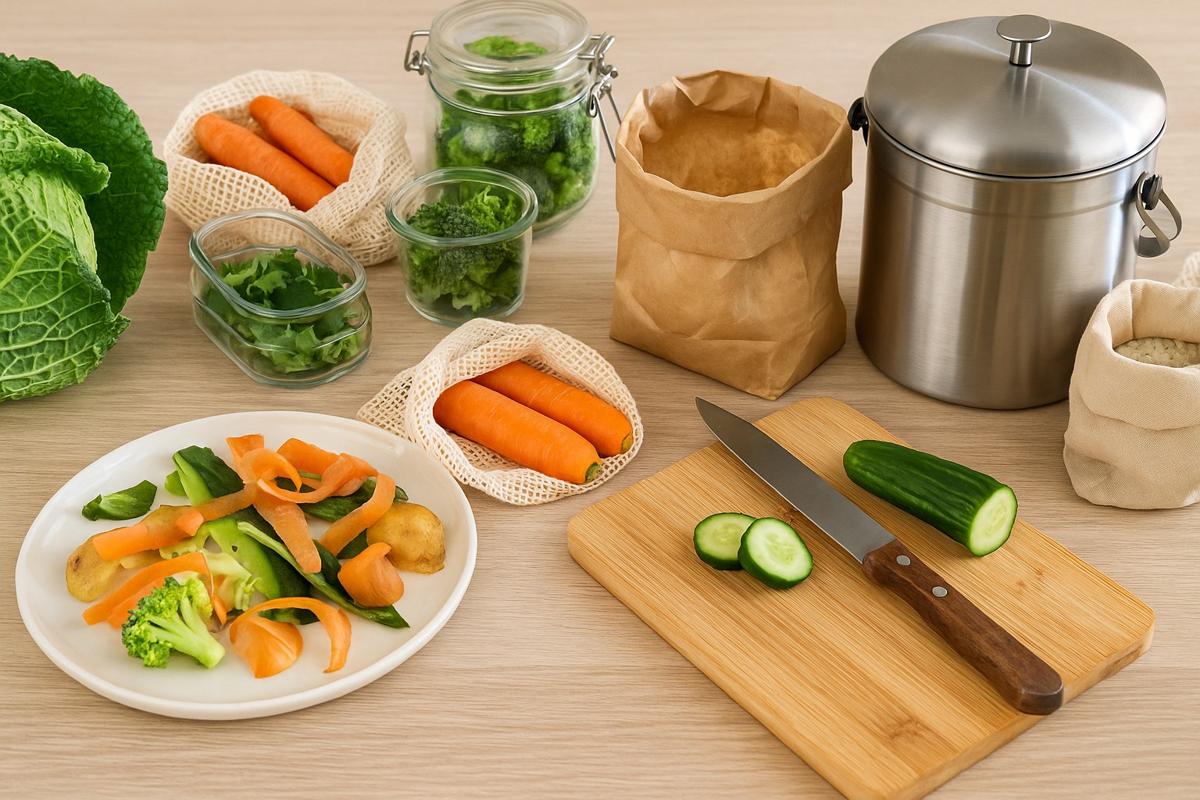The Clean Plate: A Guide to Zero-Waste Cooking at Home

Food waste in modern times serves as more than discarded kitchen items because it reveals our behavior patterns that need transformation. Zero-waste cooking requires no perfection since it involves transforming our entire ingredient management process. The zero-waste cooking approach exists to honor food while saving money and protecting the environment.
Table of Contents
ToggleWhy Waste Less in the Kitchen?
We have all experienced the habit of discarding wilted vegetables together with abandoned leftovers. The same food scraps that we discard today can become part of our meals tomorrow and next weekend. Zero-waste cooking involves making the most out of what you already possess.
The Bigger Picture: Why It Matters
The typical household kitchen produces surprising amounts of waste. The Waste and Resources Action Programme (WRAP) published a 2021 report which showed UK homes discard 6.6 million tonnes of food annually while this waste accounts for three-quarters of the national food waste total. The impact? Food waste in landfills produces environmental damage while costing the UK population £14 billion each year through unnecessary expenses.
Food waste sent to landfills decomposes into methane which produces stronger greenhouse gas effects than carbon dioxide. Learning mindful cooking techniques helps us decrease both waste generation and our environmental impact starting from our home kitchens.
What Is Zero-Waste Cooking?
Zero-waste cooking requires you to utilize every part of your ingredients including peels and stalks together with leftovers. The practical method of zero-waste cooking helps you reduce waste while enhancing flavors in your dishes. Cooking with zero waste requires both creative thinking and strong purpose in the kitchen.
The practice does not eliminate composting and disposal but extends the life of ingredients until they exit your kitchen.
5 Simple Shifts Toward Zero-Waste Cooking
1. Shop With a Plan
A zero-waste kitchen requires you to avoid spontaneous purchases. Before shopping you should create weekly meal plans followed by a list of specific ingredients you need. Check your fridge and pantry contents before going to the store because you probably possess more ingredients than you realize.
When shopping for loose fruits and vegetables choose them instead of packaged options and use your own containers to buy grains and pulses and spices in bulk quantities. The practice of buying in bulk helps you obtain the right amount of products while minimizing packaging waste.
2. Store Smarter
Food waste occurs mainly because items deteriorate before we have time to consume them. Master the correct methods for storing produce by learning to wrap herbs with a damp towel and placing apples away from bananas. Use date labels on leftovers to prevent them from disappearing in the back of the fridge. Quality storage containers represent an important investment that produces substantial benefits.
3. Cook Creatively With What You Have
The practice of zero-waste cooking requires you to think outside the box. Turn your leftover rice into two different dishes by making fried rice or rice pudding. Soft carrots? Roast them into a dip. Broccoli stems? Chop the stems into small pieces to stir-fry them with other ingredients.
4. Use the Whole Ingredient
Using every edible part in cooking is the principle behind “root to stem” and “nose to tail” methods. Beet greens can be sautéed, citrus peels can be zested into desserts, and bones can be simmered into broth. The outer layers of carrots and potatoes contain many nutrients so scrub them clean before cooking them with their skins on.
5. Compost What You Can’t Use
Every cooking effort will result in some food waste that includes onion skins and tea bags and eggshells. The process of composting transforms unwanted food scraps into valuable soil that becomes a source of nutrients. The practice of composting should be essential for every zero-waste kitchen because you can either maintain a backyard compost bin or use a countertop caddy for council pickup.
Delicious Zero-Waste Recipes to Try
Veggie Scrap Broth
Store veggie scraps like onion ends and carrot peels and herb stems in a freezer container before boiling them with peppercorns and bay leaves to create a delicious broth.
Banana Peel Curry
Banana peel curry represents a popular Indian dish that transforms discarded kitchen waste into a flavorful and aromatic meal. Prepare banana peels for cooking by cleaning them then cutting them into thin strips before cooking them with onions and garlic and your preferred curry spices.
Stale Bread Pudding
Stale bread should not be discarded because it can be transformed into either a sweet dessert or a savory bake. Mix eggs with milk and herbs (or cinnamon and sugar) before baking until the mixture turns golden brown. The dish provides cozy comfort while producing no waste.
Kitchen Habits That Support Zero-Waste Living
- Freeze your leftover food into individual portions which will serve as fast meals during weekdays.
- A designated “eat me first” container in your fridge helps you avoid wasting food that has been forgotten.
- Establish regular check-ups for your produce once per week and prepare older vegetables for soup preparation.
- Teach your household members about the items that can be recycled and composted.
The process becomes simpler and more enjoyable when everyone in the family participates because it teaches children sustainable habits from an early age.
Long-Term Benefits
- Zero-waste cooking delivers environmental advantages while providing additional benefits to users.
- The practice of zero-waste cooking enables you to cut expenses through reduced purchasing and product utilization.
- Cooking from scratch allows you to consume nutritious food while avoiding processed packaged products.
- The discovery of new tastes becomes possible through innovative recipes and traditional culinary practices.
- Your kitchen decisions become empowering because you understand their positive impact on the environment.
The process of understanding food will deepen your appreciation for its growth process and production journey and the amount of work needed to deliver it to your table.
A Greener Table, One Meal at a Time
The path to zero-waste living remains imperfect for every person. Small actions such as vegetable scrap reuse and better meal planning create substantial environmental benefits. Through practice, the kitchen transforms into an area where waste does not dominate and all ingredients serve their intended purpose.
Final Thoughts
The practice of zero-waste cooking represents a return to kitchen common sense rather than a passing trend. The practice involves using available resources while showing respect for your food and making decisions which benefit your household and the surrounding environment. Every cook regardless of experience level can discover new knowledge while rethinking established methods in the kitchen.
Published by Post Master
Post Master has been a blogger since Aug 2024, writing well-researched articles on news, lifestyle, tech, travel, finance, food, and automotive with clear, accurate insights that engage a broad audience. See More Posts. View more posts







